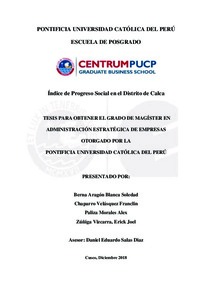| dc.contributor.advisor | Salas Diaz, Daniel Eduardo | |
| dc.contributor.author | Berna Aragón, Blanca Soledad | |
| dc.contributor.author | Chaparro Velásquez, Franclin | |
| dc.contributor.author | Paliza Morales, Alex | |
| dc.contributor.author | Zúñiga Vizcarra, Erick Joel | |
| dc.date.accessioned | 2019-04-16T14:51:26Z | |
| dc.date.available | 2019-04-16T14:51:26Z | |
| dc.date.created | 2018-12 | |
| dc.date.issued | 2019-04-16 | |
| dc.identifier.uri | http://hdl.handle.net/20.500.12404/13986 | |
| dc.description.abstract | La presente tesis tiene como objetivo principal elaborar un índice que compare las tres
dimensiones del progreso social para el distrito de Calca que permita medir y determinar el
nivel de desarrollo del distrito al margen de la inversión ejecutada. La elaboración del IPS se
construyó en base a los parámetros de la metodología del Social Progress Imperative. La
investigación es de enfoque cuantitativo, alcance descriptivo, diseño no experimental y de
tipo transaccional. El instrumento utilizado en la investigación es la recopilación de la
información mediante encuestas, que se basan en 58 preguntas entre abiertas y cerradas, con
el objetivo de recolectar los datos obtenidos de las encuestas realizada a los jefes de hogar de
cada familia del distrito de una muestra determinada para proceder con el levantamiento de
información y análisis estadístico Los resultados se presentaron de acuerdo con las
dimensiones, los componentes y cada una de las ocho zonas del distrito que se determinaron
para la presente investigación.
Los resultados de la zona 1 presentaron los mejores resultados debido a que es una
zona urbana. El IPS en esta zona es de 36.74, este resultado guarda relación con el IPS de la
ciudad de cusco que está un poco más por encima pero se debe considerar que Calca es uno
de los distritos con déficit de progreso social.
La zona 2 al igual que zona 1 se encuentra con un valor superior al IPS del distrito,
34.08 para esta zona lo posiciona en la escala de valores del Social Progress Imperativ como
muy bajo pero aun así está por encima de los valores de IPS del a zonas restantes. Esto llama
la atención ya que esta zona al igual que las 2, 3, 4, 5 y 6 es zona rural.
Las zonas 3, 4, 5 y 6 tienen resultados aún más bajos que los de la zona 1. Los IPS de
estas zonas están entre 18 y 28. Esto se debe principalmente a que son zonas rurales que están
en un proceso de urbanización, pero sin un planeamiento adecuado. | es_ES |
| dc.description.abstract | The main objective of this thesis is to produce an index that compares the three
dimensions of social progress for the district of Calca that allows measuring and determining
the level of district development regardless of the investment made. The elaboration of the
IPS was built based on the parameters of the Social Progress Imperative methodology. The
research is of a quantitative approach, descriptive scope, non-experimental design and
transactional type. The instrument used in the research is the collection of information
through surveys, which are based on 58 open and closed questions, with the objective of
collecting the data obtained from the surveys made to the heads of households of each family
in the district. Sample determined to proceed with the collection of information and statistical
analysis the results were presented in accordance with the dimensions, the components and
each of the eight zones of the district that were determined for the present investigation.
The results of Zone 1 presented the best results because it is an urban area. The IPS in
this area is of 36.74, this result is related to the IPS of the city of Cusco that is a little more
above but it must be considered that Calca is one of the districts with deficit of social
progress.
Zone 2, as well as zone 1, has a value higher than the IPS of the district, 34.08 for this
zone, it places it in the Social Progress Imperativ scale of values as very low, but it is still
above the IPS values of the remaining areas. This is striking because this area, like 2, 3, 4, 5
and 6, is a rural area.
Zones 3, 4, 5 and 6 have even lower results than those in zone 1. The IPS of these
zones are between 18 and 28. This is mainly due to the fact that they are rural areas that are in
an urbanization process but without proper planning. | es_ES |
| dc.language.iso | spa | es_ES |
| dc.publisher | Pontificia Universidad Católica del Perú | es_ES |
| dc.rights | info:eu-repo/semantics/closedAccess | es_ES |
| dc.subject | Indicadores sociales--Perú--Calca (Cuzco : Provincia) | es_ES |
| dc.subject | Indicadores económicos--Perú--Calca (Cuzco : Provincia) | es_ES |
| dc.subject | Investigación cuantitativa | es_ES |
| dc.title | Índice de progreso social en el distrito de Calca | es_ES |
| dc.type | info:eu-repo/semantics/masterThesis | es_ES |
| thesis.degree.name | Maestro en Administración Estratégica de Empresas | es_ES |
| thesis.degree.level | Maestría | es_ES |
| thesis.degree.grantor | Pontificia Universidad Católica del Perú. CENTRUM | es_ES |
| thesis.degree.discipline | Administración Estratégica de Empresas | es_ES |
| renati.advisor.dni | 06659592 | |
| renati.author.dni | 44672728 | |
| renati.author.dni | 43747354 | |
| renati.author.dni | 41939452 | |
| renati.author.dni | 45150991 | |
| renati.discipline | 413307 | es_ES |
| renati.level | https://purl.org/pe-repo/renati/level#maestro | es_ES |
| renati.type | https://purl.org/pe-repo/renati/type#tesis | es_ES |
| dc.publisher.country | PE | es_ES |
| dc.subject.ocde | https://purl.org/pe-repo/ocde/ford#5.02.04 | es_ES |





